GORDON: Batman is the hero Gotham deserves but not the one it needs right now.
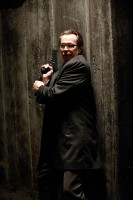 Those words, spoken by Commissioner Gordon at the end of 2008’s “[amazon_link id=”B004LWZWGK” target=”_blank” ]The Dark Knight[/amazon_link],” set in motion a fateful conspiracy that labeled Batman a murderer and Harvey Dent—who died, unbeknownst to the public, as the vengeful Two-Face—a crime-fighting crusader who paid the ultimate price. Predicated on that lie, Gotham City enacted tough new laws that put criminals behind bars or drove them beyond Gotham’s borders.
Those words, spoken by Commissioner Gordon at the end of 2008’s “[amazon_link id=”B004LWZWGK” target=”_blank” ]The Dark Knight[/amazon_link],” set in motion a fateful conspiracy that labeled Batman a murderer and Harvey Dent—who died, unbeknownst to the public, as the vengeful Two-Face—a crime-fighting crusader who paid the ultimate price. Predicated on that lie, Gotham City enacted tough new laws that put criminals behind bars or drove them beyond Gotham’s borders.
Director/writer/producer Christopher Nolan says, “Our story picks up eight years later, when it seems that Batman and Commissioner Gordon have succeeded—the Dark Knight is no longer needed in Gotham. In that regard, Bruce Wayne has won the battle, but he is traumatized by what happened and doesn’t know how to move on from being the figure of Batman. ‘The Dark Knight Rises’ very much deals with the consequences of his and other characters’ actions in the previous films.”
With this film, the last in his Dark Knight trilogy, Nolan completes the story arc he commenced with 2005’s “Batman Begins.” He recalls, “We were all very excited to bring this tale full circle; that was our chief inspiration for returning to Gotham. We also felt a tremendous sense of responsibility to fulfill expectations based on the first two movies while giving the audience something they hadn’t seen before. It was a tricky balance.”
The filmmakers and cast were also intent on maintaining a balance between heart-pounding action and intimate emotion. Producer Emma Thomas affirms, “Right from the start, Chris set out to make each of these films something that could not be categorized into any one genre. ‘The Dark Knight Rises’ has all of the excitement and fun that a big summer movie ought to have. The action is huge, but the story and characters are equally, if not more, important, because it’s hard to care about all the bells and whistles if there isn’t something to engage you in an emotional way.”
Producer Charles Roven adds, “We all want to be wowed, but we also want to be invested. Regardless of the scope, Chris has never lost his focus on the story and relationships, which goes back through all of his movies.”
At the center of the story through all three films is one character. Nolan states, “Our guiding impulse in this telling of the Batman legend has always been to follow Bruce Wayne’s journey. That was something I was very keen on, as were (co-writers) David Goyer and my brother, Jonah (Nolan).”
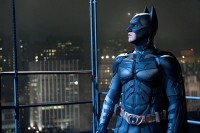 Christian Bale, who reprises the film’s title role, details, “In ‘Batman Begins,’ you see the tragedy and the pain that motivates this angry young man, who feels useless and is searching for a path—who wants to find out who he is and what he can become. Then in ‘The Dark Knight,’ he’s discovered that path. He is useful; he is doing what he imagines is the best thing for him to be doing in his life. Now, we are eight years on and he has lost the one thing that gave him a purpose…until he is forced to deal with a new threat to the city and to himself.”
Christian Bale, who reprises the film’s title role, details, “In ‘Batman Begins,’ you see the tragedy and the pain that motivates this angry young man, who feels useless and is searching for a path—who wants to find out who he is and what he can become. Then in ‘The Dark Knight,’ he’s discovered that path. He is useful; he is doing what he imagines is the best thing for him to be doing in his life. Now, we are eight years on and he has lost the one thing that gave him a purpose…until he is forced to deal with a new threat to the city and to himself.”
That threat comes in the form of a merciless, masked villain named Bane, who makes his presence known to the citizens of Gotham with an explosive display of power. While the Scarecrow was a madman and the Joker an anarchist, “Bane is a terrorist in both his mentality and his actions,” says actor Tom Hardy, who plays Batman’s new arch-nemesis. “He is physically intimidating and he’s also very intelligent, which makes him even more dangerous.”
Nolan relates, “In deciding on who the next villain would be, it was imperative that it was someone completely different from the Joker—that he be a brute force. The physical component of what Bruce Wayne does as Batman is of extraordinary importance, and we had not truly challenged that in the first two films. I really wanted to see Batman meet his match physically, as well as intellectually. Bane is raw strength with a fanatical devotion to duty, and that combination makes him unstoppable.”
“This is the first time it appears highly unlikely that Batman will come out on top in a physical altercation,” Bale allows. “He has been dormant for years, so he’s in a weakened condition to begin with, and Bane is not only incredibly strong but ruthless in terms of his sheer militancy and the ideology that drives him.”
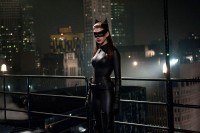 Initially, however, it is not Bane who draws Bruce Wayne out of Wayne Manor; it is an intriguing encounter with a particularly skilled thief named Selina Kyle—better known in the Batman canon as Catwoman. Nolan says, “We felt very strongly that we should have Catwoman in this film, but we always look for an organic way of grounding the characters in our world. Selina is a cat burglar, a grifter, a classic movie femme fatale, really. That was my way in, and we drew the iconic figure of Catwoman from that.”
Initially, however, it is not Bane who draws Bruce Wayne out of Wayne Manor; it is an intriguing encounter with a particularly skilled thief named Selina Kyle—better known in the Batman canon as Catwoman. Nolan says, “We felt very strongly that we should have Catwoman in this film, but we always look for an organic way of grounding the characters in our world. Selina is a cat burglar, a grifter, a classic movie femme fatale, really. That was my way in, and we drew the iconic figure of Catwoman from that.”
The only member of the main cast who counts this film as her first collaboration with Nolan, Anne Hathaway admits, “It’s hard to reveal anything about Selina Kyle because she is intensely private and very mysterious. She has her own code of ethics, which sometimes involves doing things that other people might consider questionable.”
Screenwriter Jonathan Nolan says, “Something about her morally ambiguous philosophy finally gives Batman someone he can relate to. In a weird way, she’s the yin to his yang. The dynamic between them is so fresh—the playful way she kind of pokes fun at him—it sparks a connection between them and takes some of the somberness away from his character.”
“The Dark Knight Rises” introduces two new allies for Bruce Wayne and, by extension, Batman. Marion Cotillard plays Miranda Tate, a wealthy philanthropist, who sits on the board of Wayne Enterprises and later becomes a trusted friend. Joseph Gordon-Levitt joins the ensemble as another original character: Gotham City police officer John Blake, who impresses Commissioner Gordon with his courage and integrity.
Gary Oldman returns to the role of Gotham City’s top cop, Commissioner Gordon, who withheld the truth of Harvey Dent’s demise at great personal cost. “He respects Batman’s sacrifice, but allowing the citizens of Gotham to be fed a lie goes against everything that Gordon believes in,” the actor says.
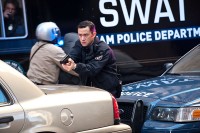 Bruce Wayne’s loyal butler, Alfred is portrayed once more by Michael Caine. Nolan says, “Alfred and Bruce have the strongest of emotional bonds, which has been tested in one way or another in each film, but in ‘The Dark Knight Rises,’ it’s tested as never before. As somebody who cares deeply for Bruce, Alfred questions the decisions he’s making and the direction his life is going, and that inevitably brings about conflict.”
Bruce Wayne’s loyal butler, Alfred is portrayed once more by Michael Caine. Nolan says, “Alfred and Bruce have the strongest of emotional bonds, which has been tested in one way or another in each film, but in ‘The Dark Knight Rises,’ it’s tested as never before. As somebody who cares deeply for Bruce, Alfred questions the decisions he’s making and the direction his life is going, and that inevitably brings about conflict.”
Another person who has been entrusted with the knowledge of Batman’s true identity is Wayne Enterprises’ ingenious CEO Lucius Fox, again played by Morgan Freeman.
Jonathan Nolan remarks, “One of the great pleasures of working on this film is the opportunity to write again for Michael Caine, Gary Oldman and Morgan Freeman. The common link of their three characters is that each has represented a father figure for Bruce Wayne, the closest, of course, being Alfred. But Alfred, Gordon and Lucius have all, in their own way, shown him different aspects of how to be a better man.”
Throughout the trilogy, Fox has equipped Batman with his ever-evolving resources, from his Batsuit, to the Tumbler, to the agile Bat-Pod, which enabled the Dark Knight to maneuver nimbly through the streets of Gotham City. In this film, he can finally navigate above them, via his new airborne vehicle—part helicopter, part jump jet and aptly named The Bat.
The director also raised the bar for “The Dark Knight Rises” in expanding on his use of IMAX cameras. Nearly half of the movie was shot with the large-format cameras, utilizing ultra resolution 15 perf/65-millimeter film. Nolan states, “We got great results with the IMAX cameras on the last film. I appreciate what it offers from the technical side, but I’m most interested in what it can give me as a storytelling tool. How can it help me pull the audience deeper into this world? IMAX provides the broadest possible canvas, creating the most immersive experience.”
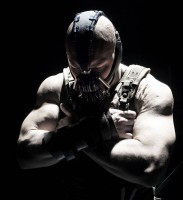 Principal photography on “The Dark Knight Rises” took the cast and filmmakers across three continents, and from the ground up. The action begins in mid-air, where Bane initiates his violent rampage with a deadly hijacking and kidnapping. Much of the harrowing aerial sequence was actually captured in mid-flight in the skies above Scotland. Filming in the UK was also done in Wales and at Cardington, the massive airship hanger that has become something of a home base for Nolan and company, housing a number of the interiors.
Principal photography on “The Dark Knight Rises” took the cast and filmmakers across three continents, and from the ground up. The action begins in mid-air, where Bane initiates his violent rampage with a deadly hijacking and kidnapping. Much of the harrowing aerial sequence was actually captured in mid-flight in the skies above Scotland. Filming in the UK was also done in Wales and at Cardington, the massive airship hanger that has become something of a home base for Nolan and company, housing a number of the interiors.
The global footprint of the production also stretched as far as India, as well as to the United States. For the first time, three separate cities provided locations and backdrops for Gotham City, with scenes filmed in Pittsburgh, Los Angeles, and the city sometimes nicknamed Gotham, New York.
Nolan offers, “When you look back on the films, you can see the world we’re living in reflected, but we don’t want to be specific about it. We just come at the stories from the point of view of what concerns us. What gives us fear? What gives us hope? What would require a hero of Batman’s stature to rise up in our world?”
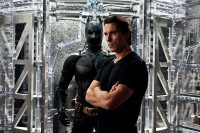 GORDON
GORDON
The Batman has to come back.
BRUCE
What if he doesn’t exist anymore?
GORDON
He must. He must.
Fulfilling the promise he made in “Batman Begins,” Bruce Wayne has had Wayne Manor rebuilt, “just as it was.” But the mansion has become more of a refuge than a home for its owner, who has retreated behind its stately walls.
David S. Goyer, who crafted the story of “The Dark Knight Rises” with Christopher Nolan, says, “The reason we decided on a gap of eight years is that there needed to be significant enough time for the Batman legend to have faded a bit, and we wanted Bruce Wayne himself to have withdrawn behind a veil of rumor and mystery.”
Taking on the dual role of Bruce Wayne and Batman for the third and final time, Christian Bale says, “Bruce feels absolutely isolated since the tragedy of losing the woman he loved, Rachel, and the terrible turn of events with what happened to Harvey Dent. He carries a certain amount of guilt that if he had not chosen the course of becoming Batman, none of that would have happened. His belief has been rocked, and that has caught up with him, physically and emotionally. But how much longer can he allow the pain of what has happened in his life control what he does with his life? And at what point does it start to become completely self-destructive?”
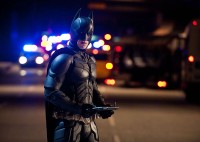 Nolan observes that, in giving up the guise of Batman for all those years, Bruce has, in a very real way, sacrificed both identities. “We come back to find a man who is no longer on a mission, even though that had always been the goal.”
Nolan observes that, in giving up the guise of Batman for all those years, Bruce has, in a very real way, sacrificed both identities. “We come back to find a man who is no longer on a mission, even though that had always been the goal.”
“On the surface, Gotham has become what Bruce had hoped for,” Thomas adds, “but because it was all founded on a lie, nothing is quite that simple. It falls along the lines of ‘be careful what you wish for’ because without Batman, Bruce has no sense of purpose.”
“The reason I have always gravitated to the character of Batman is that, as often noted, he is a superhero with no super powers, apart from his wealth,” Nolan says. “His extraordinary nature has always come down to his extreme motivation and sheer dedication, which makes him a very credible individual.”
“One of the great things about this character is that the least relatable thing about him is his billionaire status. Having those kinds of resources is something very few people could ever fathom. But the rest of it is understandable from an emotional perspective,” Bale comments.
“It’s been very rewarding to watch Christian chart the progression of his role through the three films,” says Nolan. “He always had a strong commitment to finding the truth of the character, and I think you especially see that in this film, where he really embraced that Bruce is older, but not necessarily wiser. It’s a very thoughtful performance, and that’s what you consistently get from a talent like Christian.”
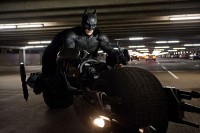 In spite of Bruce Wayne’s seeming absence, Gotham’s most influential citizens have gathered at Wayne Manor for a benefit honoring Harvey Dent Day. It is the perfect hunting ground for an audacious and undeniably attractive cat burglar, whose name is Selina Kyle. Her encounter with Bruce Wayne has an unexpected effect on him.
In spite of Bruce Wayne’s seeming absence, Gotham’s most influential citizens have gathered at Wayne Manor for a benefit honoring Harvey Dent Day. It is the perfect hunting ground for an audacious and undeniably attractive cat burglar, whose name is Selina Kyle. Her encounter with Bruce Wayne has an unexpected effect on him.
Bale reveals, “What really impacts Bruce is that, after years of isolation, he’s meeting this woman he finds fascinating and funny. He suddenly recognizes he’s been seeking something, even unconsciously…that he’s lost all the color in his life and needs some human contact.”
Anne Hathaway asserts, “I think Bruce owes Selina a big thank you because he was leading a pretty lonely life until she came in and got his blood pumping and reminded him that there are fun people out there in the world. One of the things that fans have always enjoyed about Bruce and Selina is the playful side of their relationship. They may operate very differently, but they actually have a lot in common: they like to keep certain things hidden; they’re usually several steps ahead of everyone else in the room; and they prefer to dress in black,” she smiles. “I had so much fun working with Christian. He’s quick to laugh and have a good time, but he’s also so solid. He’s the kind of actor that raises your game.”
Acting alongside Bale was not the only reason Hathaway was excited to portray what she calls “one of the most famous female comic book characters ever.” She recounts, “I did look back at some archival comics and read a lot about Bob Kane’s inspirations for Catwoman, but the most important thing was to be Catwoman in this film and fit into Christopher Nolan’s Gotham City. I’m such a huge fan of Chris’s. With Batman, he has been able to pose some really interesting philosophical questions, while shooting these spectacular action sequences and also finding the humor. It was a thrill to work with someone whose mind is so brilliant and whose talent is so very evident.”
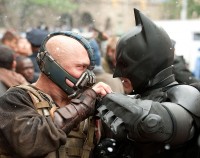 Nolan offers, “We needed to find the balance between the classic image of the character and a believable person you care about. Casting Anne Hathaway in the role was the key to that. She was able to combine those facets seamlessly so they aren’t in conflict, but one is amplifying the other.”
Nolan offers, “We needed to find the balance between the classic image of the character and a believable person you care about. Casting Anne Hathaway in the role was the key to that. She was able to combine those facets seamlessly so they aren’t in conflict, but one is amplifying the other.”
“I think Selina does what is necessary to survive,” relates Hathaway, “and that includes crossing a few lines that others might find unforgivable. Even if she wants to change, it’s hard to escape your past…and she does have a past. That makes her vulnerable, especially these days when anyone with a computer or smartphone can look up almost anything about you. Everybody has moments in life when they think, ‘If I knew then what I know now…’ Selina might like the opportunity not to have to live by the choices she was forced to make up to this point.”
Bane, however, has no such compunctions. Everything he does is a means to an end. Tom Hardy attests, “Bane has come to do a job and has no feelings of remorse or shame about the death and destruction he’s causing. There is nothing ambiguous about Bane. He is clearly a villain…just a horrible piece of work.”
Perhaps less widely known than Catwoman, Bane is infamous among Batman comic fans for the terrible harm he inflicts on the Caped Crusader. Having recently worked with Hardy on “Inception,” Nolan knew he could project an extreme physical and psychological threat despite having to act from behind a mask. “When you’re creating a monstrous presence like Bane in a movie, you could concentrate just on the physical or you could focus on the more psychological aspects. With Tom, I knew I would get the whole package. He is such an incredible actor; he was able to depict this beast of a man who has exceptional fighting skills, but also able to convey the soul of someone who is damaged inside as well as out. Tom is the kind of actor who relished the challenge of having to generate an entire performance with most of his face covered up. What he is able to do with just his eyes is truly amazing.”
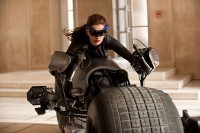 Hardy states that the mask was not a deterrent when given an opportunity to rejoin the director, especially on a Dark Knight film. “Chris called me up and said there was a role I might be good for, but he wasn’t sure I’d be interested because I’d have to wear a mask for several months. He wouldn’t tell me anything else about the character, except that he was a very bad guy. I said, ‘Let me get this straight: you want me to come and work with you, travel around the world, have a stunt team and all the weapons I could possibly want to play with, and all I have to do is wear a mask?’ He answered, ‘Yeah, pretty much…’ And I said, ‘I’m in!'”
Hardy states that the mask was not a deterrent when given an opportunity to rejoin the director, especially on a Dark Knight film. “Chris called me up and said there was a role I might be good for, but he wasn’t sure I’d be interested because I’d have to wear a mask for several months. He wouldn’t tell me anything else about the character, except that he was a very bad guy. I said, ‘Let me get this straight: you want me to come and work with you, travel around the world, have a stunt team and all the weapons I could possibly want to play with, and all I have to do is wear a mask?’ He answered, ‘Yeah, pretty much…’ And I said, ‘I’m in!'”
Unlike Batman, Bane does not wear a mask to conceal his identity, but to anesthetize himself against excruciating pain, resulting from injuries he suffered long ago. Countering Nolan’s concerns, Hardy says, “I didn’t feel limited by the mask. What’s cool about it is, as soon as you put it on, you become the character.”
The actor adds that his portrayal of Bane entailed creating a contradiction between the voice and the body. “He is florid in his speech, but has the physicality of a gorilla. So while he is quite articulate, we also wanted to establish a very imposing presence.”
Working underground and undetected, Bane is plotting a multi-pronged attack on Gotham, involving firepower, finance and fear.
Part of his plan requires neutralizing the police department, still led by Commissioner Gordon, although “to a certain extent, Gordon was more useful to the political leaders of Gotham when the city was overrun by organized crime,” Nolan points out. “Now that is under control, so there are people eyeing his job, presuming he’s no longer needed. But Gordon has been struggling with the fact that all of this is based on a false foundation.”
“It’s a secret that’s eaten away at him for years,” confirms Gary Oldman. “Crime is at an all-time low in Gotham, but Gordon knows that it’s tainted. Now he’s ready to come clean, but there doesn’t seem to be a right time or place, and he also questions if the city is ready for the truth. Then, because of Bane, he’s in the field again. I think he’s like a soldier who likes to be on the front lines, getting his hands dirty. He’s probably been doing a lot of paper pushing in the intervening years and that has dampened his spirits. Now you really feel like the old Gordon is back.”
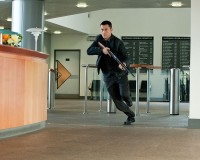 Gordon finds a new protégé in policeman John Blake, whose devotion to the job impresses his boss. Emma Thomas says, “Gordon definitely sees something of himself as a young cop in John Blake. Everyone else seems to have lost focus because things have been so good, but Blake is the first to realize that something’s up, and Gordon recognizes those instincts by promoting him and putting him on his team.”
Gordon finds a new protégé in policeman John Blake, whose devotion to the job impresses his boss. Emma Thomas says, “Gordon definitely sees something of himself as a young cop in John Blake. Everyone else seems to have lost focus because things have been so good, but Blake is the first to realize that something’s up, and Gordon recognizes those instincts by promoting him and putting him on his team.”
Describing his role, Joseph Gordon-Levitt says, “John Blake is the kind of guy who probably always wanted to be a cop and dedicates himself to being excellent at his job. He is someone who believes in what he does and I admire that in anybody. In the midst of a lot of cynicism, he remains proud to be a police officer.”
Nolan comments, “Commissioner Gordon and Bruce Wayne have become somewhat jaded, so we wanted to contrast that with a younger, more idealistic individual who, in a way, represents where they’ve come from. Joe really captured the strength and courage of a man who refuses to back down, regardless of the odds.”
The character of Miranda Tate can also relate to Bruce, albeit from a place of affluence. Cast in the role, Marion Cotillard notes, “They both have a lot of money and are trying to use it in a good way, so they understand each other right away.”
Bale agrees. “Miranda is somebody who is encouraging Bruce to use his resources for the betterment of Gotham through an environmental project. She is beautiful, smart and altruistic, and all the good that she aspires to earns his respect and also intrigues him a great deal.”
 Having collaborated with Nolan on his original drama “Inception,” Cotillard and Gordon-Levitt were both excited to reunite with the director on the finale of his Dark Knight trilogy. Gordon-Levitt says, “Amidst all the spectacle, I think the honest human dramas are what distinguish the way Chris approaches these movies. For an actor, that’s inspiring and a lot more fun.”
Having collaborated with Nolan on his original drama “Inception,” Cotillard and Gordon-Levitt were both excited to reunite with the director on the finale of his Dark Knight trilogy. Gordon-Levitt says, “Amidst all the spectacle, I think the honest human dramas are what distinguish the way Chris approaches these movies. For an actor, that’s inspiring and a lot more fun.”
“I love working with Chris,” adds Cotillard. “He fosters a great feeling of family on the set, even on such a huge movie. And he has the intelligence and imagination to take you on an unbelievable adventure and make it something you believe. It was especially interesting to work with him to create the character of Miranda because she doesn’t exist in the comics.”
A member of the board of Wayne Enterprises, Miranda’s affluence makes her a vital ally to Bruce when the company becomes the target of a hostile takeover. On a more personal level, Nolan says, “She is looked at by Alfred and Lucius as a woman who could perhaps bring Bruce out of his own exile and remind him that there is more to life than sitting alone in the Batcave. Marion has an incredibly appealing presence with an exotic glamour. She brought a combination of warmth and wisdom to Miranda that provides a great sense of hope for Bruce.”
Morgan Freeman again plays Wayne Enterprises’ brilliant inventor, Lucius Fox. “Although Lucius works for Bruce, he has been a mentor to him,” observes Freeman. “Compared to Lucius and Alfred, Bruce is still a relatively young man, so between the two of them, they try to keep his moral compass pointed in the right direction.”
Charles Roven offers, “Lucius has always been the brains behind the tools that Bruce uses to become Batman, and he fulfills that function once again. But he has also grown to have great fondness for Bruce and, like Alfred, he is trying to pull him out of the dark emotional place he’s been in.”
Inarguably, the person closest to Bruce is Alfred Pennyworth, who, Bale says, “has been the one constant throughout his life…the only family he has left. Alfred has seen him grow up, watched him become a man and seen the pain he’s gone through. He accepted Bruce’s need to honor his parents and try to right the wrongs of their deaths, but equally he recognizes that his parents would be desperately unhappy that he’s not living any kind of life. There’s always been that caution from Alfred that this is not the best thing for Bruce in the long run, and it comes to a head in this story.”
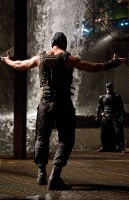 Nolan expounds, “When we first explored the relationship between Alfred and Bruce in ‘Batman Begins,’ it was immediately apparent to me that I only understood Alfred’s endorsement of Bruce’s extreme action in creating the Batman persona if there would be an end to it—if there was seen to be a time when Batman had acted as a catalyst to change Gotham and then Bruce could move on from that. In ‘The Dark Knight Rises,’ we’re dealing with Alfred’s frustration that Bruce has not been able to extricate himself from being Batman. Even though he has no longer been going out every night wearing the cape and cowl, he clearly has not been able to put it behind him, and Alfred feels it’s his duty to help Bruce find a way to do that.”
Nolan expounds, “When we first explored the relationship between Alfred and Bruce in ‘Batman Begins,’ it was immediately apparent to me that I only understood Alfred’s endorsement of Bruce’s extreme action in creating the Batman persona if there would be an end to it—if there was seen to be a time when Batman had acted as a catalyst to change Gotham and then Bruce could move on from that. In ‘The Dark Knight Rises,’ we’re dealing with Alfred’s frustration that Bruce has not been able to extricate himself from being Batman. Even though he has no longer been going out every night wearing the cape and cowl, he clearly has not been able to put it behind him, and Alfred feels it’s his duty to help Bruce find a way to do that.”
Reprising the part of Alfred, Michael Caine remarks, “It hurts Alfred to tell Bruce that he knew there was nothing for him in Gotham City except pain and tragedy, but he was right. I was thinking that, in terms of the audience, Alfred represents us in this incredible world. He is our spokesman. He’s not tough like the others; he reacts like an ordinary human being in this situation.”
“What Michael has always brought to Alfred is tremendous heart,” Nolan says. “Watching Christian and Michael play out the unique relationship between these two characters has been one of the great joys of working on these films.”
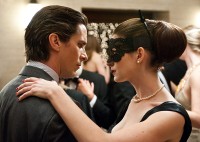 BRUCE
BRUCE
That’s a brazen costume for a cat burglar.
SELINA
Yeah? Who are you pretending to be?
From heroes to villains, the costumes have been an integral part of bringing the characters of the Dark Knight trilogy to life, starting, of course, with the indelible silhouette of Batman.
Following “Batman Begins,” the Batsuit was significantly redesigned for “The Dark Knight,” resulting in improved comfort and flexibility, especially in the neck and shoulders. As the saying goes, “If it ain’t broke, don’t fix it,” so costume designer Lindy Hemming and her team made no changes to the suit for “The Dark Knight Rises.”
The multi-layered Batsuit was comprised of 110 separate pieces, each of which had to be replicated dozens of times over the course of the production. The base layer was made of a polyester mesh that is utilized by the military and high-tech sports manufacturers because of its breathability and moisture-wicking properties. Individually molded pieces of flexible urethane were then attached to the mesh, forming the overall body armor plating. Adding another level of protection, light but strong carbon fiber panels were placed inside the sections on the legs, chest and abdomen. The cowl was sculpted from a cast of Bale’s face and head and then molded for a perfect fit.
There were also ten different versions of the iconic cape, ranging in length and shape—from shorter ones, used in action scenes, to the glider cape that snaps into the shape of spread batwings.
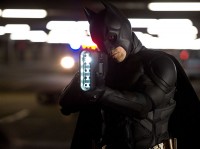 The image of Bale in the Batsuit had the requisite effect on his castmates. Gordon-Levitt confirms, “When Christian put on that suit, I didn’t have to make believe: I was talking to Batman. It doesn’t happen very often, but every now and then when I’m shooting a movie, I have a moment when it feels like real life. That was definitely one of the strongest of those moments I’ve ever had.”
The image of Bale in the Batsuit had the requisite effect on his castmates. Gordon-Levitt confirms, “When Christian put on that suit, I didn’t have to make believe: I was talking to Batman. It doesn’t happen very often, but every now and then when I’m shooting a movie, I have a moment when it feels like real life. That was definitely one of the strongest of those moments I’ve ever had.”
Tom Hardy, whose character is supposed to be more than a match for the Dark Knight, recounts, “I remember the first time I saw Christian in the makeup chair, and I arrogantly thought to myself, ‘That’s not a problem; I can handle him.’ And then, on the set, Batman showed up. It wasn’t Christian Bale anymore; he absolutely was Batman.”
In designing Bane’s costume, Hemming needed it to look “like an amalgam of all sorts of bits and pieces he cobbled together, as he passed through some very remote places. We made parts of his vest, for example, from fragments of an old military tent. His clothes are militaristic, but are not in any way a uniform.”
Obviously, Bane’s most distinctive feature is the menacing-looking mask, fastened to his face, which continually pumps pain medication into him, keeping the agony from his violent past at bay. “His life depends on it,” Nolan states. “This is somebody whose history is carried with him in a very visible way on his face, making him, in a very real sense, monstrous.”
“We designed the mask to be animalistic,” Hemming says. “It had to look completely different from Batman’s cowl…and it could not be black.”
 The mask was built by the costume effects department, using a digitally mapped model of Tom Hardy’s face and skull. Costume effects supervisor Graham Churchyard explains, “To us, the Bane mask had to fit like a prosthetic; however, unlike a prosthetic, it had to look like it was engineered out of metal. We were able to take Tom’s computer cast and 3D model each rigid piece to the contours of his head so it was tight to his face, with no gaps.”
The mask was built by the costume effects department, using a digitally mapped model of Tom Hardy’s face and skull. Costume effects supervisor Graham Churchyard explains, “To us, the Bane mask had to fit like a prosthetic; however, unlike a prosthetic, it had to look like it was engineered out of metal. We were able to take Tom’s computer cast and 3D model each rigid piece to the contours of his head so it was tight to his face, with no gaps.”
As it turned out, “tight” was an understatement. Hemming attests, “It was gripping Tom’s head like a vice. With his assistance and patience, we made it as tight as it could ever have been. There was a magnetic removal panel on the front, so everything you see has a series of magnets underneath it, and everything beneath that has a rubber seal that pressed into Tom’s skin and was held on by tension. The fact that he tolerated it, let alone acted with it, was astounding.”
While Bane’s mask is entirely about function over form, the one worn by Selina Kyle is a combination of both. Nolan says, “It was crucial that there be a reason for the appearance of the character, not just as Selina but as Catwoman. For me, the jumping off point was figuring out how to derive a cat ear shape for her without it literally being a pair of ears. I eventually fixed on an idea of a pair of night vision goggles that would flip up onto her head and almost accidentally form that silhouette. Once I had that concept, Lindy and her team were able to realize it beautifully. The idea was that everything that contributes to the iconography of the character has a sense of logic.”
 “Her Catsuit is also very practical, enabling her to disappear into the darkness and be ready for action,” Hemming adds. “When she’s not in the suit, she always dresses in black, adjusting for the occasion. She’s a classic chameleon.”
“Her Catsuit is also very practical, enabling her to disappear into the darkness and be ready for action,” Hemming adds. “When she’s not in the suit, she always dresses in black, adjusting for the occasion. She’s a classic chameleon.”
Hathaway notes, “You need to get the sense that she could leave in a hurry…that she could bring her entire identity, or rather identities, with her whenever she had to flee.”
Selina’s Catsuit was actually two pieces, but with her hip-hugging utility belt in position, it looks like one. Completing the ensemble are elbow-length gloves and thigh-high boots with spike heels that also serve a purpose. “They double as very effective weapons,” Hemming nods.
There were two layers of material used to make the Catsuit, the outer one being polyurethane coated spandex, embossed with a hexagonal pattern. “It’s very simple and streamlined,” Hemming says. “It’s emphasizing the shape of her body without being too revealing.”
While it is true that the skintight costume covered the actress from head to toe, Hathaway counters, “It doesn’t really hide much, so I worked with a movement coach to make sure that I was going to be very comfortable in my body. If you had to wear a Catsuit in front of the entire world, I guarantee you would get your butt to the gym,” she laughs.
 BANE
BANE
The shadows betray you
because they belong to me.
Leading up to and all during filming, Christian Bale, Tom Hardy and Anne Hathaway all engaged in personalized training regimens in preparation for their action scenes.
Although Bale was embarking on his third outing as Batman, he had to demonstrate more of a physical arc in “The Dark Knight Rises,” as Bruce had not been the Caped Crusader for so many years. In the first two films, Bale employed a mixed martial arts discipline called Keysi, but that would have to be modified, reflecting his current condition and in response to the style of his opponent. Stunt coordinator Tom Struthers clarifies, “We didn’t drop Keysi, but we evolved it to another level to deal with the brutality of Bane.”
Bruce Wayne’s physical aptitude may have depleted over time, but Bale’s was as honed as ever. Fight coordinator Buster Reeves, who doubled the actor on the first two films, says, “He picks things up unbelievably fast. I told the other stunt guys that he’d only have to walk through the moves twice and he’d have it. And, true to form, Christian came in, broke down each section twice, and then could perform it full tilt. It was amazing.”
Reeves switched sides to serve as Hardy’s stunt double in “The Dark Knight Rises.” He continues, “Tom was already in fantastic shape when he arrived and he was up for anything. In fact, we practically had to kick him out of rehearsals because he wanted to train all the time. He wore us out.”
 “Tom did a wonderful job becoming this very formidable adversary,” says Bale. “He is a very bold actor that I admire greatly, and it was fantastic working with him.”
“Tom did a wonderful job becoming this very formidable adversary,” says Bale. “He is a very bold actor that I admire greatly, and it was fantastic working with him.”
One of the main challenges of choreographing Bane’s fights was the juxtaposition of timing. Reeves outlines, “His movements are fast, but he’s speaking very slowly and methodically. Trying to move with speed while talking very deliberately is harder than you think. It took a lot of rehearsals to break everything down into beats and determine where Tom should deliver his lines within the action.”
When Batman and Bane do battle, “it is just a great piece of cinema,” Roven states. “It is the irresistible force meeting the immovable object, and it’s awesome to watch.”
Nolan affirms, “This was very much a toe-to-toe, blow-to-blow physical clash, and Christian and Tom put an incredible amount of work into it. Just the demands of the costumes—one character has the lower half of his face obscured, the other the upper half—posed problems. They had trouble hearing each other because they were wearing those masks and working in very noisy environments while performing these feats.
“It required very intense preparation,” the director continues. “And when it came time to shoot, Christian and Tom worked extremely well together. It was frighteningly real, and quite intimidating to see these larger-than-life characters really go at it. There are plenty of other large-scale action scenes in the film, but that face-to-face confrontation between these two adversaries was something I really felt was the centerpiece of the film.”
That being said, Thomas points out, “The actors were doing some pretty remarkable stuff, but Anne was having to do it backwards and in high heels, as they say. She did almost all of her stunts herself. It was an enormous undertaking, but she just attacked it with a kind of precision and an impressive level of commitment, and it really pays off in the movie.”
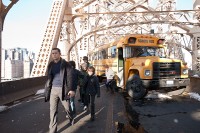 Struthers agrees. “Selina has to be tough enough to handle herself in any situation, and Anne did extraordinarily well. She was already a very good dancer, and dance and martial arts go hand-in-hand. She listened and learned fast and trained exceptionally hard right up to her last day of filming.”
Struthers agrees. “Selina has to be tough enough to handle herself in any situation, and Anne did extraordinarily well. She was already a very good dancer, and dance and martial arts go hand-in-hand. She listened and learned fast and trained exceptionally hard right up to her last day of filming.”
Hathaway says, “I saw it less as a challenge and more as an opportunity to go to a place I had never been required to go before. I also had the benefit of an amazing team, including Tom and my stuntwoman, Maxine Whittaker, who could not have pushed me harder or been more supportive. I knew I was in great hands with them and with Chris. Coming into this role, I knew it was going to be some of the most exciting work I’d ever done and I was going to have the time of my life, but my expectations were far exceeded.”
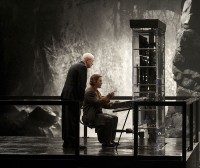 SELINA
SELINA
My mother warned me about getting
into cars with strangers.
BRUCE
This isn’t a car.
One of the challenges of playing Catwoman was riding the Bat-Pod, the two-wheeled street machine that made its debut in “The Dark Knight.” Designed by Chris Nolan and production designer Nathan Crowley, the Bat-Pod was made a reality by special effects supervisor Chris Corbould and his team.
The Bat-Pod sports the same monster truck tires as those on the original Batmobile—better known in the Dark Knight trilogy as the Tumbler. Although it looks rather unwieldy, the Bat-Pod is fast and maneuverable, as well as fully equipped with blast cannons, 50-caliber machine guns and grappling hook launchers.
The Bat-Pod is street-worthy but not easy to ride, requiring strength and a specific technique to control it. During the making of “The Dark Knight,” the only one who could actually drive it was professional stunt rider Jean-Pierre Goy. Goy did return to ride the Bat-Pod for scenes in “The Dark Knight Rises.” However, he did have one obvious drawback, as Hathaway relates: “I was standing there with Chris, looking at the Bat-Pod, and he was telling me about Jean-Pierre and how he’s the only person in the world who can drive it. And I turned to him and said, ‘Can he look like a woman?'”
Struthers had the exact same thought, noting, “There’s no way that a man would ride the Bat-Pod the same way as a woman. But we found the right lady for the job.”
Professional motocross racer and stunt rider Jolene Van Vugt—the first female ever to backflip a full-size dirt bike—came on board to double Hathaway when Catwoman hits the streets of Gotham on the Bat-Pod. “I was beyond excited when I got the call,” Van Vugt recalls. “When they asked me if I thought I could ride it, I said, ‘You give me the opportunity, and I guarantee I can do it.’ The biggest hurdle was getting used to the body position because of the way you have to lean forward. It was just a matter of finding my balance and building up my comfort level, but within a few hours I was racing around, having fun.”
Corbould did make some adjustments to the Bat-Pod to allow for a female rider. “It’s a heavy machine, so we remade some of the frame in aluminum, including the whole front end, to make it lighter and give Jolene a chance to do some spectacular maneuvers,” he says.
The Bat-Pod and the Tumbler have given Batman both mobility and firepower on the streets of Gotham, but in this film, he can finally go “wheels up,” thanks to Lucius Fox’s latest contribution to his arsenal: The Bat. Nolan and Crowley collaborated on the design of the state-of-the-art airborne machine, which borrows elements of an Apache attack helicopter, an Osprey prop jet, and a Harrier jump jet. And, naturally, it had to come in black.
In keeping with the idea that The Bat was an invention of Wayne Enterprises Applied Science Division, Crowley says, “We took the approach that this would be a credible military project, and that gave us a good basis. From a design standpoint, the most important thing was that The Bat fit into the same family as our Batmobile. Initially, it was a matter of finding the shape; we went through many different design sketches before I began modeling something.”
Nolan adds, “From a function perspective, the idea was a double-bladed chopper, where the rotors are configured underneath the vehicle and the air is channeled down through the vents above. It has flaps and louvers that change its aerodynamics and allow it to maneuver around buildings.”
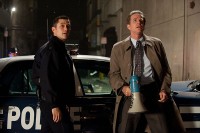 Chris Corbould details, “There are a lot of moving parts: the cockpit opens; the aerial flaps all operate; and it has working rotors and lights. It’s nearly 30 feet long and 17 feet wide and weighs about 3,000 pounds; it’s a big piece of machinery. We employed a variety of different methodologies to make The Bat ‘fly,’ because Chris’s mantra is he wants to do as much as possible before letting CGI take over. So we had it supported on wires, running along high lines, suspended from cranes or helicopters, and mounted on a specially constructed vehicle fitted with hydraulic controls.”
Chris Corbould details, “There are a lot of moving parts: the cockpit opens; the aerial flaps all operate; and it has working rotors and lights. It’s nearly 30 feet long and 17 feet wide and weighs about 3,000 pounds; it’s a big piece of machinery. We employed a variety of different methodologies to make The Bat ‘fly,’ because Chris’s mantra is he wants to do as much as possible before letting CGI take over. So we had it supported on wires, running along high lines, suspended from cranes or helicopters, and mounted on a specially constructed vehicle fitted with hydraulic controls.”
Corbould admits that the one concession they had to make was that The Bat could not take off and soar on its own. “To get something like that off the ground was beyond our capabilities. I’d be a very rich man if I could build something like that that could actually fly,” he laughs.
SELINA
There’s a storm coming, Mr. Wayne.
The gripping action of “The Dark Knight Rises” is ignited in mid-flight, with the skyjacking of a CIA plane carrying a man named Dr. Pavel, who is obviously someone of value to the U.S. government, as well as others with less savory intentions. This is where we first meet Bane, who proves what an ingenious and utterly ruthless villain he is. Just as Bane is revealed, a huge C-130 Hercules transport plane approaches from above, and four terrorists, suspended on cables, rappel out of the cargo bay. Landing on the wings of the CIA’s turboprop and shooting out the windows, they then tether the plane to the Hercules, rendering the smaller aircraft powerless.
Given Nolan’s preference for doing as much in-camera as possible, most of the prologue was actually shot in mid-air over Inverness, Scotland. From start to finish, it was a coordinated, multi-departmental feat of timing and precision.
Planning of the high-altitude prologue began months in advance, primarily to ensure everyone’s safety. Executive producer Kevin De La Noy attests, “A lot of what we do either pushes the envelope or punches right through it, but we’re always very careful because safety margins are put there for all the right reasons.”
Prior to filming in live action, the visual effects team, led by supervisor Paul Franklin, created an animatic—a low-resolution computer animation of the scene—so the different departments could analyze what would or would not work. Franklin says, “Through our initial pre-visualization, we could figure out what was going to be stunts, what was going to be special effects, and what would require visual effects. It really helped all the departments to understand what their part would be in the finished sequence.”
Tom Struthers went to great measures to eliminate risks to the aerialists who would be dropping from the C-130 onto the turboprop. The stunt coordinator recounts, “To my knowledge, it’s never been done—where four people flew out of the back of an aircraft on separate lines and land on another plane. So we did a great deal of testing with dummies and different kinds of rigs before we ever put an actual person up. We had emergency procedures in place to allow them to cut away and parachute to the ground, which thankfully were never necessary. The guys who did it were fantastic.”
There were also preparations being done on the ground, where the fuselage of the CIA plane would eventually fall to earth. Everything was cleared from the area to ensure that there was no threat to people or wildlife. The weather also cooperated, giving the filmmakers clear skies.
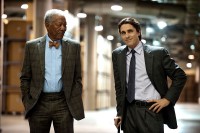 When everything was in place, Nolan and cinematographer Wally Pfister caught all the action from a helicopter that had to match air speeds with the two planes. The best testament to the efficiency and expertise of those involved was that the entire sequence, which was originally scheduled to take up to nine days, was accomplished in two. “It was a ride for us, and I think it will be for the audience as well,” Nolan says.
When everything was in place, Nolan and cinematographer Wally Pfister caught all the action from a helicopter that had to match air speeds with the two planes. The best testament to the efficiency and expertise of those involved was that the entire sequence, which was originally scheduled to take up to nine days, was accomplished in two. “It was a ride for us, and I think it will be for the audience as well,” Nolan says.
The struggle unfolding inside the turboprop plane was filmed at Cardington, a converted airship hangar north of London. Corbould’s team constructed the fuselage of the plane on a gimbal, which was able to tip the aircraft from horizontal to vertical and rapidly roll it from side to side, severely testing the equilibrium of the cast and crew.
“I don’t know why on Chris’s sets we always end up tumbling around or turning upside down,” Pfister says, only half-joking. “Logistically, it makes for quite a challenge when you’re shooting it, but it also makes for a great bit on film.”
The film’s prologue was shot entirely with IMAX cameras, which were utilized throughout the production, including on all of the major action scenes. “I love working with the IMAX cameras,” states Nolan, “because it adds scale and broadens the tableau of the image. We learned a lot with our use of the cameras on ‘The Dark Knight,’ so we were able to refine our techniques to give us better exposure and so forth. There was a lot of technical innovation, which enabled us to take it to the next level.”
Pfister affirms, “IMAX is a very immersive format in both picture and sound because of the way the image is filling your vision and how the sound hits you from all around the theatre. We spent about six months working with Panavision and IMAX to retool the viewfinder on the cameras and craft new lenses, which allowed us to shoot in very low-light conditions. With those advancements, we were able to do things we couldn’t do on the previous film.”
Filming in low light was especially important for “The Dark Knight Rises” because a number of crucial scenes take place underground, including those in the Batcave.
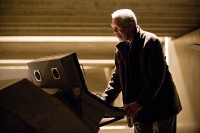 With Wayne Manor—and therefore the original Batcave—destroyed in the first film, Bruce Wayne had temporarily moved his base of operations to the Bat-Bunker. However, the mansion was rebuilt with the inclusion of a new Batcave, which reflects design elements of both earlier sets.
With Wayne Manor—and therefore the original Batcave—destroyed in the first film, Bruce Wayne had temporarily moved his base of operations to the Bat-Bunker. However, the mansion was rebuilt with the inclusion of a new Batcave, which reflects design elements of both earlier sets.
Nathan Crowley, who teamed with fellow production designer Kevin Kavanaugh on this film, explains, “Chris and I pondered how to mix the Batcave and the Bat-Bunker, which is incredibly geometric and modern and everything is cleanly recessed into the walls. It occurred to us that we could carry over the same idea by flooding the Batcave so everything is hidden underwater. When you enter, it’s just a cave, but you press a button and up come these perfect cubes that hold different objects, from the Batsuit to a super computer.”
Nolan observes, “It’s a terrific combination of the tactile reality of the Batcave and the functionality of the Bat-Bunker.”
The Bat-Bunker was again erected at Cardington. However, the new Batcave set, complete with working waterfalls, was constructed on Stage 30 of Sony Studios in Culver City, California. The soundstage was ideal because it contains a water tank that can hold more than 720,000 gallons of water.
Currents of water were also a main feature of Bane’s base of operations, found in the sewer system beneath Gotham City. The set was constructed at Cardington, where the cavernous space allowed the production to build tunnels leading to a concrete and corrugated steel structure, several stories high. In lighting the set, Pfister says, “I suggested we use heavily overexposed lights to turn it into something that feels like an arena. So we have these really bright points of light that go to stark white and help to establish the harshness of the environment.”
Cardington also housed an even more imposing multi-leveled set: a hellish prison, which, apart from being beneath the ground, is a far cry from Bane’s lair. The prison is a rough-hewn labyrinth of stone cells in a vast abyss. The barred doors of the cells are unlocked because there is only one escape: an impossibly high vertical shaft leading to the surface. There were actually two shafts constructed at Cardington, the taller being 120 feet high.
Exteriors above the prison were filmed in Jodhpur, India, where the forbidding landscape added to the desolation.
In sharp contrast to the remote location, the exterior of palatial Wayne Manor was an existing mansion found in Nottingham, England. Although Bruce fulfilled his promise to rebuild the house “brick for brick,” the interior was designed to be more sterile, a house rather than a home.
In the first two movies, Chicago had doubled as Gotham City, but for the conclusion of the trilogy, three separate cities stood in for Gotham: Pittsburgh, Los Angeles and New York. In a few sequences, the action overlapped locations, beginning in one city and seamlessly transitioning to another. Pfister says, “It was extremely challenging in terms of continuity. We were shooting in different cities, in different seasons, at different times of day, so it required an enormous amount of planning to match the lighting and make sure everything made sense. It all had to be mapped out very carefully with Chris and the location managers to figure out precisely when we were going to shoot on what streets.”
In Pittsburgh, more than 11,000 extras flocked to Heinz Field for the scene in which Bane kicks off his revolution with an explosive show of force. The home of the city’s beloved Steelers football team became the gridiron of the Gotham Rogues, who sported the black and gold colors of the stadium’s real-life resident team. Executive producer Thomas Tull is also a co-owner of the Pittsburgh Steelers, so he was proud to see them represented, even fictionally, in the film.
A number of Pittsburgh Steelers stars were drafted to “play” for the Gotham Rogues. On the opposing side, the current Mayor of Pittsburgh, Luke Ravenstahl, joined in the game, playing the kicker for the Rapid City Monuments.
Emma Thomas notes, “When you’ve been working on a movie for a few months, you might start to think you’re the center of the universe. Then you bring in the Steelers with the Pittsburgh fans, and you see a whole new level of stardom. It was thrilling to have them there that day.”
“We had a great time in Pittsburgh,” Nolan adds. “Everyone was extraordinarily welcoming to us, especially considering we were shutting down entire sections of the city for weeks at a time. That really helped us to achieve a lot of shots that would have been virtually impossible to do anywhere else.”
The production took advantage of the fact that the turf of the stadium was scheduled to be replaced for the approaching football season. Corbould’s special effects department strategically placed explosives that were detonated along the field. A platform was built on top of the existing surface to give a player on the Gotham Rogues a running lane and to give the illusion that the players chasing behind him were falling into the growing chasm. The collapsing field and resulting crater were rendered digitally by Paul Franklin’s visual effects team.
In Los Angeles, a number of notable sites were used for interior sets, including the L.A. Convention Center, which was turned into the Applied Science Division of Wayne Enterprises; historic Union Station, which became a makeshift courtroom; and a building on South Spring Street, which was transformed into the trading floor of the stock exchange.
The exterior of the stock exchange was appropriately located in the financial hub of Wall Street in New York City. Over two weekends, the production closed down the entire financial district to shoot two of the film’s climactic confrontations, involving main cast, stunt teams, and several thousand extras. There were ultimately 600 stunt people engaged in the action, so in order to teach everyone the carefully choreographed moves, Struthers had them all broken down into groups and then sub-divided into smaller units.
“Filming on a location like Wall Street is always going to be logistically complex, particularly with the sheer number of people we had,” Nolan says. “We had tremendous cooperation from the city, and everything went very smoothly, which is a testament to everyone involved. I’ve been very lucky to have found excellent people to work with on these films, in all departments. I know I can rely on them to offer valuable input and always give me their best, and that makes my job much easier.”
The final weeks of principal photography were spent in New York City, where locations included the Trump Tower, which served as the exterior of Wayne Enterprises, and the Queensboro Bridge, the upper span of which was closed for two days for filming, including a shot of Batman overlooking the city he was willing to sacrifice everything to protect.
Nolan states, “Gotham has always drawn a lot from New York. It’s a heightened version of it, but that was always the inspiration, hence the name Gotham. So I felt that we should get more of New York into this film, specifically because ‘The Dark Knight Rises’ is very much about Gotham…more than the previous two films have been.”
From people to places, the themes of the film are all captured in the movie’s score. The music was composed by Hans Zimmer, marking his fourth collaboration with Nolan, including all three Dark Knight films. “It’s a joy and a privilege to work on these movies and to work with somebody like Chris Nolan, who invites comments and welcomes your observations,” he says.
For this final installment, the composer included echoes of the earlier scores, but, he offers, “We went in a completely different direction for Bane. I wanted to use a big symphony orchestra, but I said to them, ‘I’m going to make you unlearn everything you’ve learned. I’m going to treat you as if you were a primeval drum circle.’ And it turned out to be very liberating for them, like a musical adventure,” he smiles.
Zimmer also prominently incorporated a chant into the music associated with Bane, which became, for the composer, an opportunity to reach out to fans to participate in the film’s soundtrack. People were invited to send in their chants via UJAM—a website that can be used to compose, produce, and publish music—and thousands responded from all over the globe. Submissions were then synched to create the haunting chant heard in the film. Zimmer recalls, “I suggested to Chris that this was a way to give something back to the fans and let them be a real part of this world. There was some question about if it would work, but it all came together beautifully.”
“I have never worked with someone so dedicated to the idea that the real risk is in playing it safe,” Nolan remarks. “Hans taught me that you sometimes have to go in what appears to be the wrong direction to discover all the possibilities, and that without exploring those possibilities you can never do anything truly exceptional. He sets creative goals for every film that are higher than you ever thought practical…or even reachable.”
Zimmer says that, like the character, the theme accompanying Selina Kyle is “full of ambiguity, which is far more interesting than just being bad or good. Chris’s movies always contain a certain amount of ambiguity, and I try to put some of that into the music.”
The one musical thread spanning all three films is the music Zimmer composed for Bruce Wayne. “He’s got the simplest of themes; it’s just a little two-note motif that never quite resolves,” he describes. “I always wanted the music to somehow pose the question of ‘what if’ for Bruce. But I do think that this movie leads to a sort of resolution—that those same two notes have shifted and now provide an answer.”
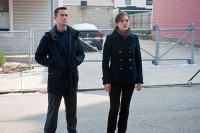 Reflecting on the completion of the Dark Knight trilogy, Christian Bale says, “It was very bittersweet when I took off the cowl for last time, because it’s meant so much to me personally to play this character. It never stopped giving me goose bumps to stand in that suit, because I recognize the honor of having portrayed this icon. And I can’t help but feel immensely proud.”
Reflecting on the completion of the Dark Knight trilogy, Christian Bale says, “It was very bittersweet when I took off the cowl for last time, because it’s meant so much to me personally to play this character. It never stopped giving me goose bumps to stand in that suit, because I recognize the honor of having portrayed this icon. And I can’t help but feel immensely proud.”
Christopher Nolan concludes, “Bruce Wayne’s story has fascinated people for more than 70 years because it’s a great story. We were thrilled to bring our interpretation of this legend to the screen with these three films. It has been an extremely gratifying experience. We are very proud of this ending, and we hope the audience shares our excitement.”
All images © 2012 Warner Bros. Entertainment Inc. All Rights Reserved.
Related Articles:
